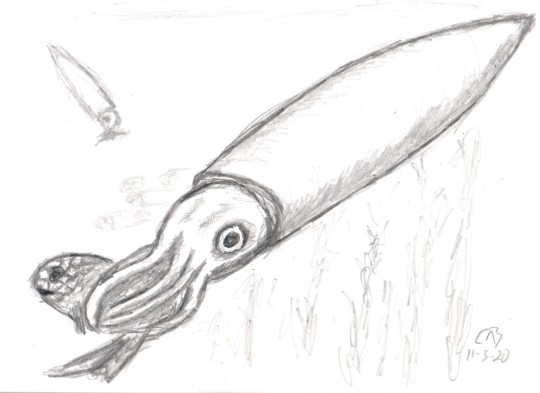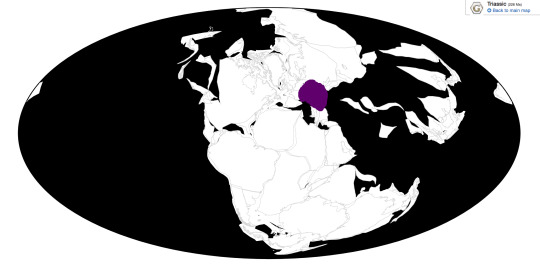#clarkeiteuthis conocauda
Photo

Clarkeiteuthis conocauda, a proto-squid, hunting Leptolepis bronni, Posidonia Shale, Jurassic period
#squid#clarkeiteuthis conocauda#leptolepis bronni#cephalopad#posidonia shale#jurassic period#artists on tumblr#sketch daily
2 notes
·
View notes
Text
Phragmoteuthis

By Ripley Cook
Etymology: Fence squid
First Described By: Mojsisovics, 1882
Classification: Biota, Archaea, Proteoarchaeota, Asgardarchaeota, Eukaryota, Neokaryota, Scotokaryota Opimoda, Podiata, Amorphea, Obazoa, Opisthokonta, Holozoa, Filozoa, Choanozoa, Animalia, Eumetazoa, Parahoxozoa, Bilateria, Nephrozoa, Protostomia, Spiralia, Platytrochozoa, Lophotrochozoa, Mollusca, Conchifera, Cephalopoda, Coleoidea, Belemnoidea, Phragmoteuthida, Phragmoteuthidae
Referred Species: P. bisinuata, P. huxleyi, ?P. ticinensis
Status: Extinct
Time and Place: 247 to 190 million years ago, from the Anisian of the Middle Triassic to the Sinemurian of the Early Jurassic.

Phragmoteuthis is known from Austria, England, Germany, and Switzerland.

Physical Description: Externally, Phragmoteuthis would have resembled a modern squid. However, it is a member of the now-extinct belemnoids. It had a long mantle, an internal shell, and ten equally-sized hook-bearing arms, none of which were developed into tentacles. Unlike squids, the internal shell of belemnoids had a distinct hollow phragmocone, like earlier Paleozoic cephalopods. This shell also had a long, flat portion anteriorly called a proostracum. The proostractum in Phragmoteuthis was wide and lobed. Posteriorly the shell formed a pointed, horny guard called a rostrum. These rostra are the most commonly found belemnoid fossils. Several specimens of Phragmoteuthis preserve an ink sac, indicating that like most modern cephalopods, it produced a dark ink. Other early belemnoids preserve a pair of rhomboidal fins on the posterior mantle, allowing us to infer the presence of this in Phragmoteuthis.
Diet: It is presumed that belemnoids had similar diets to modern squids, being predators of smaller organisms such as fish.
Behavior: Little is known about belemnoid behavior. Phragmoteuthis was likely an active shallow-water predator, using the hooks on its arms to catch prey such as fish and smaller mollusks. Like all cephalopods, Phragmoteuthis would have been able to propel itself by expulsing water from its siphon. The phragmocone would have helped the animal maintain buoyancy, and the rostrum may have counterbalanced the heavier head region. Ink would have also been expelled from the siphon as a defense mechanism, to confuse potential predators and provide a chance for escape. The frequency of belemnite fossils found implies that belemnites may have been gregarious in life, which could have also applied to Phragmoteuthis.
Ecosystem: Phragmoteuthis lived in coastal areas like most other belemnoids. In fact, one formation that preserves Phragmoteuthis also fossilizes land plants like bennettitales and cycads and insects such as beetles, indicating that that specific spot in Carnian Austria was likely a shoreline. P. bisinuata lived alongside many ray-finned fish such as Sauricthys, Polzbergia, and Thoracopterus, and the other common clade of Mesozoic cephalopods: ammonites, such as Austrotrachyceras. ?P. ticinensis lived alongside ichthyosaurs such as Mikadocephalus and Mixosaurus, pachypleurosaurs such as Serpianosaurus, and more fish, including Gyrolepis, Habroichthys, and Ptycholepis. These ichthyosaurs, as well as large fish, may have fed on Phragmoteuthis, as other belemnoids are sometimes found fossilized inside ichthyosaur and pachycormid guts.
Other: The classification Phragmoteuthis has been contentious - although previously considered an abberant lineage of coleoid cephalopods, more recent authors have considered it an early belemnoid. Some well-known Jurassic species have since been reclassified as the unrelated Clarkeiteuthis. Phragmoteuthids such as Phragmoteuthis are considered transitional between earlier Paleozoic cephalopods and the later, more common belemnites.
~ By Henry Thomas
Sources under the Cut
Doguzhaeva, L., Summesberger, H., Mutvei, H., Brandstaetter, F. (2007). “The mantle, ink sac, ink, arm hooks and soft body debris associated with the shells in Late Triassic coleoid cephalopod Phragmoteuthis from the Austrian Alps”. Palaeoworld 16 (4): 272-284.
Donovan, D. T. “Phragmoteuthida (Cephalopoda: Coleoidea) from the Lower Jurassic of Dorset, England”. Palaeontology 49 (3): 673-684.
Fuchs, D., Donovan, D.T., Keupp, H. (2013). “Taxonomic revision of “Onychoteuthis” conocauda Quenstedt, 1849 (Cephalopoda: Coleoidea)”. Neues Jahrbuch für Geologie und Paläontologie Abhandlugen 270 (3): 245-255.
Fuchs, D., Donovan, D.T. (2018). “Part M, Chpater 23C: Systematic Descriptions: Phragmoteuthida”. Treatise Online 111.
Griffith, J. (2008). “The Upper Triassic fishes from Polzberg bei Lunz, Austria”. Zoological Journal of the Linnean Society 60 (1): 1-93.
Hanlon, R., Vecchione, M., Allcock, L. (2018). Octopus, Squid & Cuttlefish. University of Chicago Press.
Rieber, H. (1970). “Phragmoteuthis? ticinensis n. sp., ein Coleoidea-Rest aus der Grenzbitumenzone (Mittlere Trias) des Monte San Giorgio (Kt. Tessin, Schweiz)”. Paläontologische Zeitschrift 44: 32-40.
#Phragmoteuthis#Squid#Triassic#Mollusc#Palaeoblr#Phragmoteuthis bisinuata#Phragmoteuthis huxleyi#Phragmoteuthis ticinensis#Prehistoric Life#Paleontology#Prehistory#Triassic Madness#Triassic March Madness
154 notes
·
View notes